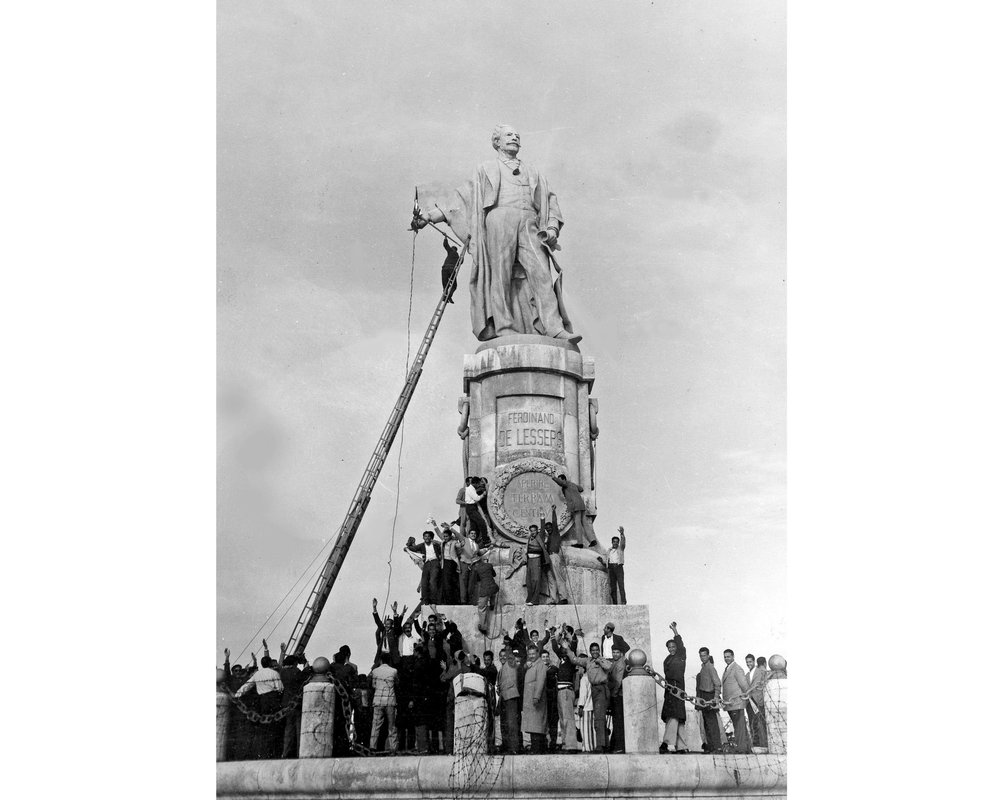
CAIRO (AP) — A proposal to bring back the statue of a French diplomat behind the idea to build the Suez Canal has stirred controversy in Egypt, with many saying it would be a salute to colonial times and a “humiliation” to the memory of tens of thousands of Egyptian laborers who died building the waterway in the 1860s.
The debate started when the daily el-Shorouk reported last month that local authorities in the Mediterranean province of Port Said were thinking of returning the statue of Ferdinand de Lesseps to where it once stood, at the northern entrance of the canal.
De Lesseps, who came to Cairo in 1833 as a consul and was later posted to Alexandria, had been inspired by the idea of joining the Red Sea and the Mediterranean. He persuaded the Ottoman governor of Egypt to build the canal and in 1859, he symbolically swung a pickax to launch the construction, which took 10 years. The canal was officially opened on Nov. 17, 1869.
A 33-foot bronze statue of de Lesseps by French sculptor Emmanuel Frémiet, was erected in Nov. 1899 at Port Said, showing the diplomat with his right hand extended to welcome visitors entering the Suez Canal, his left holding a map of the canal.
The statue was destroyed by Egyptian fighters amid the 1956 Mideast War, when Israeli forces pushed into Egypt toward the Suez Canal after Egyptian President Gamal Abdel Nasser nationalized the canal. It was later restored by the Paris-based Association des Amis du Canal de Suez, and is now housed in a shipyard in Port Fouad. The Egyptian government registered the statue as an artifact in 2019.
The el-Shorouk report said that along with the return of the de Lesseps statue, another statue would be erected next to it, showing an Egyptian farmer, symbolizing the workers who had dug the canal.
A local official in Port Said, speaking on condition of anonymity because he was not authorized to talk to reporters, told The Associated Press that no decision has yet been made and that more “public debate” is needed before the statue can be returned.
Lawmaker Mustafa Bakry on Monday condemned the proposal. Abdallah el-Senawy, a columnist for el-Shorouk, said the deaths of forced laborers during the canal’s construction was a “racist crime that requires accountability, condemnation, and an apology.”
Hundreds of thousands of Egyptian peasants were drafted into low-wage digging work with hand tools and tens of thousands died before the practice was banned and steam-powered excavators took their place.
In 1956, Nasser nationalized the canal from the British and French companies that owned it, a moment cherished by Egyptians as a defiant break from imperialist control. Britain, France and Israel invaded in response, but were ordered to withdraw by the United States and the Soviet Union, in what was seen across the Arab world as a defining victory for Nasser and Arab nationalism.
Around 10 percent of the world’s trade flows through the waterway, which is one of Egypt’s top foreign currency earners. In 2015, the government of President Abdel-Fattah el-Sissi completed a major expansion of the canal, allowing it to accommodate the world’s largest vessels.
___
Image: In this Dec. 24, 1956 file photo, Egyptian civilians climb on the statue of Ferdinand de Lesseps, the French diplomat who was behind the construction of Egypt’s Suez Canal, in Port Said, prior to blowing it up. A proposal to bring back the statue has stirred controversy in Egypt with many saying it would be a salute to colonial times and a “humiliation” to the memory of tens of thousands of Egyptian laborers who died while digging the waterway. The debate started when a newspaper reported in June 2020 that local authorities in the Mediterranean province of Port Said were thinking of returning the statue to where it once stood at the northern entrance of the canal. (AP Photo, File)




